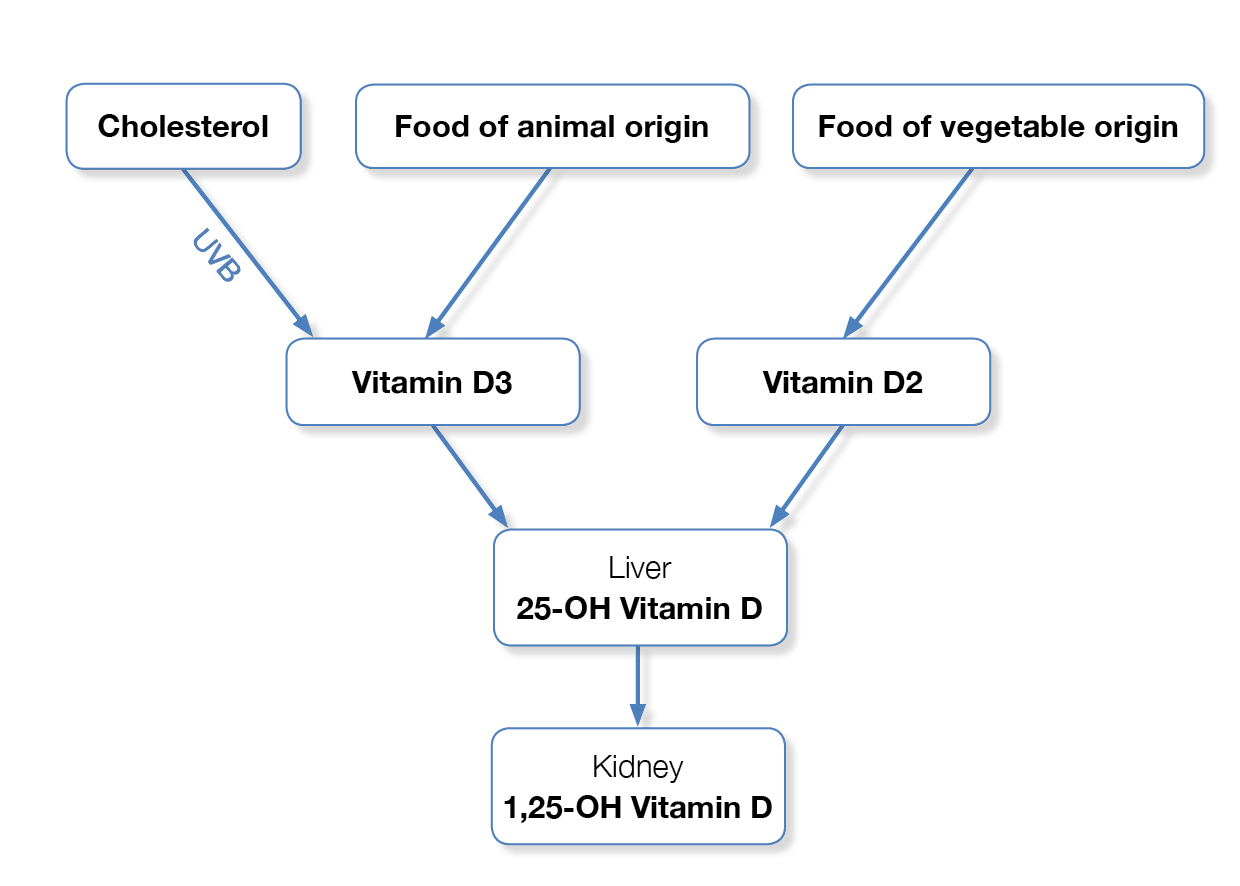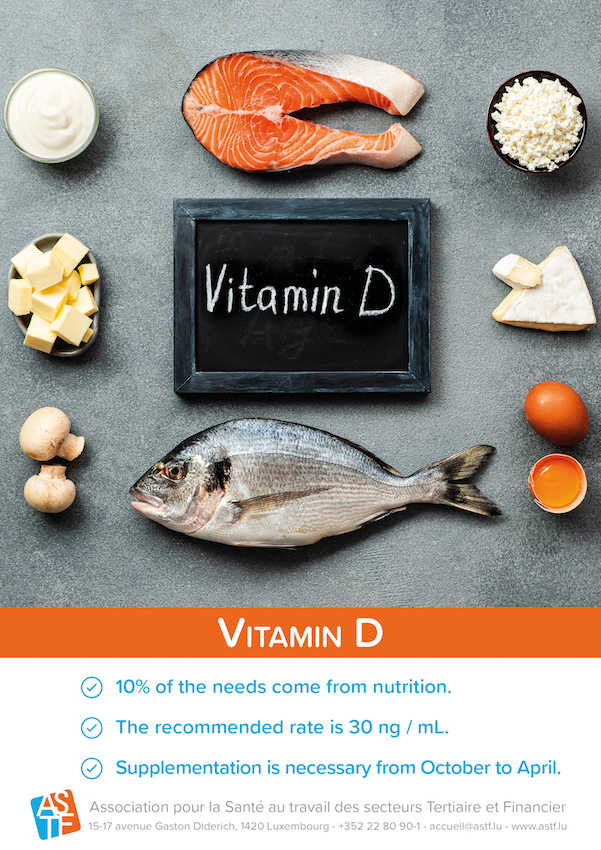Téléchargements
Vitamin D
Vitamin D is found in food and synthesized in the human body from a cholesterol derivative or by the action of sunlight (UVB). It is involved in the absorption of calcium and phosphorus by the intestines, as well as in their reabsorption by the kidneys. Vitamin D has a positive effect on bone mineralization of the skeleton and joints, as well as on muscle tone. It thus helps to prevent certain diseases such as diabetes, certain cancers and epilepsy.

Origin and metabolism
Vitamin D2 or ergocalciferol is of vegetable origin while vitamin D3 or cholecalciferol is of animal origin and occurs in concentrated form in fish liver oils and, to a lesser extent, in fish, milk, butter and cheese. This dietary intake is the source of just 10% of the vitamin D level in the blood, the rest being synthesized by our own organism.
On the skin, ultraviolet B radiation permits the formation of vitamin D3 from 7-dehydrocholesterol, a derivative of the cholesterol that is normally present in the organism. This source therefore varies widely depending on exposure to the sun (seasons, fog, region, clothing), the thickness and pigmentation of the skin.
Whether its origin is in the skin or in the diet, vitamin D is metabolized by the liver into 25-hydroxyvitamin D, whose level in the blood is routinely measured. This substance is then converted by the kidney into 1-25-dihydroxy-vitamin D, the active form of vitamin D.
Supplements
A person who is in good health, has a varied diet and regular exposure to sunlight will not normally need to take a vitamin D supplement in summer, unless he or she has a black or dark skin. However, recent studies show that a high percentage of the population does not have the minimum level of vitamin D in the blood.
The rate recommended at present is 30 ng/mL.
When we perform our check-ups, nine patients out of ten have a vitamin D level which falls short of the recommended 30 ng/mL.
Daily exposure to the sun for 12 minutes at a latitude of 38° (California or Spain) on 50% of the skin area would be equivalent to a supplement of 3000 IU per day.
Luxembourg lies at a latitude of more than 42° and is regarded as a country with a low level of sunlight between October and April. A supplement of 10 μg (or 400 IU) may prove necessary for the elderly, for persons with a dark skin colour or who have little exposure to sunlight, e.g. persons who take their car from the garage in the morning to drive to the workplace car park and then make the return journey in the evening !
As a rule, just 10% of our daily vitamin D requirement is obtained from the diet. Few types of food are rich in vitamin D which occurs mainly in oily fish (200 to 400 IU/100g), egg yolks (80 IU/100g) and liver (40 IU/100g). The diet alone is therefore not sufficient to offset the lack of vitamin D synthesis, especially in the autumn and winter.
Inadequacy and deficiency
Deficiency is defined as a blood level of 25-hydroxyvitamin D amounting to less than 25nmol/L (10 ng/ml). Inadequacy is defined as a blood level of 25-hydroxyvitamine D below 75 nmol/l (30 ng/ml). On the basis of that limit, deficiency affects more than one billion of the world’s population and over half of all postmenopausal women.
The main causes of deficiency are insufficient exposure to sunlight and a dark skin phototype. The principal risk groups are as follows :
- Elderly persons living in institutions and very old people in general ;
- Persons who are overweight (vitamin D is stored in the body fat). Obese individuals may need two to three times more vitamin D than others ;
- Persons with a dark or black skin ;
- Infants who are being breast-fed, unless the mother takes a suitable supplement ;
- Persons with limited exposure to sunlight ;
- In the autumn and winter, everyone who lives at a high latitude (above 42°), where UV-B radiation which is responsible for vitamin D synthesis is low.
Vitamin D deficiency causes weakness and muscle pains or fatigue and, at a more advanced stage, osteomalacia (bone pains and muscle fatigue) in adults and rickets in children. It increases the risk of fracture and seems to be associated with a higher risk of cardiovascular diseases and a greater risk of breast cancer, colon cancer and prostate cancer.
Recommended Supplements :
- 400 UI of vitamin D daily in the months of October to April.
- During the summer, diet rich in oily fish and outdoor activity for at least 20 minutes every day.
Vitamin D is found naturally in foods such as :
- Fish (salmon, herring, mackerel, sardines, trout, tuna) and oysters.
- Veal liver and beef liver.
- Cheeses (gouda, Emmental and Gruyère), butter and cow’s milk.
- Mushrooms (Parisian mushrooms, morels, porcini mushrooms, etc.)
- Eggs yolk.
- Avocado.
- Dark chocolate.
Find this article in PDF and the poster ’vitamin D’ to print for your premises.

